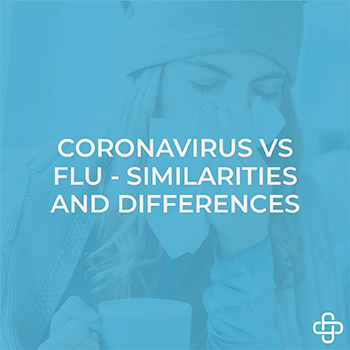Wondering what’s the difference between coronavirus vs. flu? While the influenza virus causes the common flu, COVID-19 is the respiratory illness caused by the pandemic coronavirus. Both COVID-19 and flu share many similar symptoms, making it tricky to differentiate between the two. This post will walk you through the symptoms of both contagious respiratory illnesses, their effects on your health, and key similarities and differences.

Similarities Between Coronavirus vs. Flu:
Similar symptoms shared by coronavirus vs. flu are:
- Fever (100.4 F or higher)
- Dry or wet cough
- Body ache and chills
- Difficulty breathing
- Sore throat
- Runny nose and other cold symptoms
- Muscle aches and headache
- Nausea or vomiting, especially in children
Serious complications may include:
- Acute respiratory distress
- Organ failure
- Pneumonia
- Vital organ inflammation and death
Patients with either of these illnesses may exhibit similar mild or severe symptoms. Without a diagnostic test, it is hard to detect the virus.
Want to learn more about COVID-19 symptoms? Here is an informative page with Coronavirus symptoms by CDC.gov.
Differences Between Coronavirus vs. Flu:
Here is a list of differences between coronavirus vs. flu.
Unique to COVID-19
COVID-19 symptoms that are less common with the flu are:
- Shortness of breath
- Difficulty breathing
- Loss of taste or smell
- Heaviness in chest
- Runny or stuffy nose
- Sore throat
- Tremors with chills
Combination of symptoms: Coronavirus vs. Flu
Studies on the coronavirus infection suggest that COVID-19 infection may cause two or more symptoms, whereas the flu is characterized by only one symptom.
Symptom onset:
The flu symptoms appear anywhere between one to four days after infection. According to the Centers for Disease Control and Prevention, the COVID-19 symptoms can be more gradual and may take up to 14-days to appear.
Severe Cough:
The COVID-19 cough is more severe when compared to seasonal flu. In most influenza cases, the cough is mild, dry, and short-spanned. However, COVID-19 cough is persistent and may lead to shortness of breath.
How Does It Spread – Coronavirus vs. Flu?
COVID-19:
- Person-to-Person: Coronavirus spreads between people in close contact or within 6 feet.
- Droplets: The most common spread is through respiratory droplets or aerosols.
- Surface Transmission: Coronavirus also spreads by touching contaminated surfaces.
- Fecal-oral: Studies also suggest that this virus may spread through fecal particles from an infected individual.
Flu:
- The flu virus also spreads through droplets or smaller virus particles released from the infected person.
- The smallest viral particles may linger in the air inside a closed space and may infect another person through inhaling.
People infected either with coronavirus, or the flu may not show any symptoms or even realize they are sick for several days. However, they can still spread the virus unknowingly during that time before they feel sick.
Treatment & Vaccination:
Flu:
Flu treatment involves:
- Over-the-counter pain and fever medication
- FDA-approved influenza antiviral drugs
Flu Vaccine:
Healthcare practitioners recommend taking flu vaccinations annually.
COVID-19:
There are no prescribed drugs for treating coronavirus illness yet. However, patients with severe symptoms should receive supportive care and a combination of drugs to relieve symptoms and complications.
What Is More Dangerous: The Coronavirus Disease or Seasonal Influenza?
While it is too early to conclude, the disease spread by the coronavirus is seemingly more dangerous. Both COVID-19 and flu patients often experience mild symptoms. However, the coronavirus might severely affect the respiratory system and cause short- or long-term breathing difficulties, leading to serious respiratory failure and even death.
Is It Possible To Have The Flu And COVID-19 At The Same Time?
Yes, you may test positive for the influenza virus and coronavirus at the same time. However, the diagnostic tests for both are different.
Can The Flu Turn Into COVID-19?
No, the flu cannot turn into COVID-19 or vice versa. The virus causing COVID-19 respiratory illness is morphologically different from the other.
How is COVID-19 Different From The Flu?
Without a diagnostic test, it is difficult to differentiate COVID-19 from the flu based on the symptoms alone. However, symptoms like loss of taste and smell are unique to the Coronavirus only.
How To Prepare For The Flu Season?
During this pandemic or twin-pandemic, getting a flu vaccination has become more essential than ever. Beyond vaccinations, it is important to follow general hygiene, social distancing, and other guidelines to avoid the threat of COVID-19 and the flu season coinciding together.
Axiom Medical is a long-standing healthcare management company with years of experience in employee health management, vaccination, and COVID-19 screening with onsite mobile labs and Checkin2work app. Want to learn more? Contact us today!










